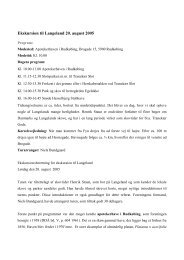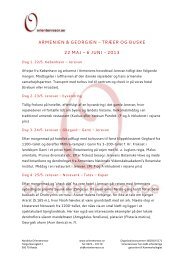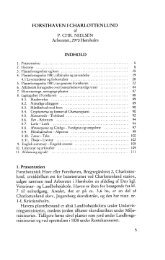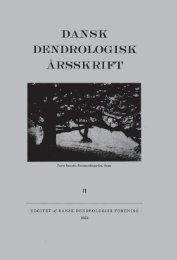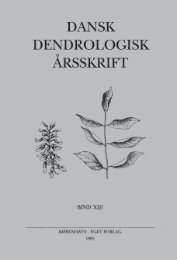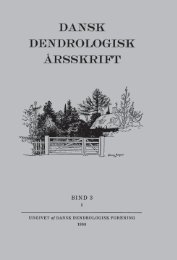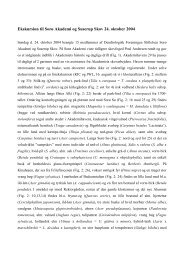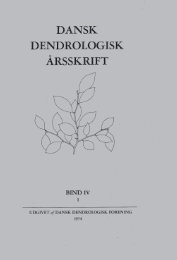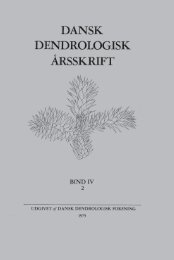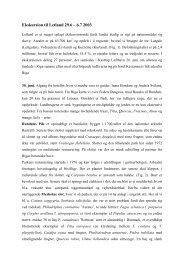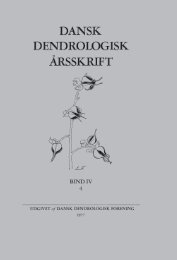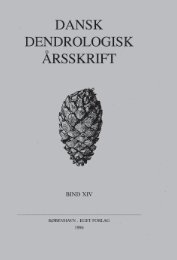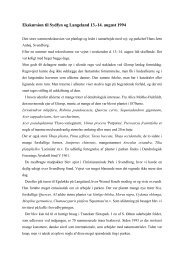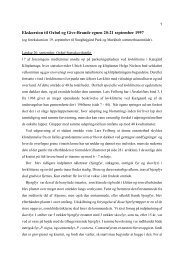Volume 2,1 (1963) - Dansk Dendrologisk Forening
Volume 2,1 (1963) - Dansk Dendrologisk Forening
Volume 2,1 (1963) - Dansk Dendrologisk Forening
Create successful ePaper yourself
Turn your PDF publications into a flip-book with our unique Google optimized e-Paper software.
80 DANSK DENDROLOGISK ÅRSSKRIFT II 1<br />
trees in the gardens from the first import. Of this - as far as I know -<br />
only one specimen had survived in Charlottenlund Forestbotanical<br />
Garden and here gave SYRACH LARSEN and collaborators the possibility<br />
finding out that this species only gave few and weak seedlings<br />
by it self but lots of fastgrowing hybrids (triploids) after pollination<br />
that nearly always took place from A. incana (L.) Moench and<br />
A. glutinosa (L.) Gaertn.<br />
Although the above mentioned three points have caused severe<br />
species-problems they shall not be mentioned further here. Future<br />
investigations may unveil lots of errors in our conceptions, but the<br />
now used means of propagations viz. cuttings, scions and controlled<br />
pollination will eliminate this source of mistakes.<br />
IV. As another species-problem that has caused some confusion<br />
we have the extremely bad custom to use a species name for hybrids<br />
and a variety (or even species) name to a mere clone. By this we<br />
get quite a false impression of the taxon a species. Salix X rubra<br />
Huds. (S. purpurea X viminalis) and S. Smithiana Willd. (S. caprea<br />
X viminalis) may be mentioned as such hybrid clones. Populus X<br />
italica Muenchh. (P. nigra italica) may examplify a not hybrid clone.<br />
If the hybrid is polymorphic, with several distinguishable types there<br />
can be some reason to use a specific name for this unity (e. g. Populus<br />
X canadensis Moench and Ulmus X hollandica Mill.) Also these<br />
cases are of minor importance and the new international rules of<br />
nomenclature have prescribed how to use names for hybrids and<br />
clones.<br />
The following points on the other hand are very difficult to deal<br />
with and the remarks below must be considered to be an attempt to<br />
discuss them in order to find a solution although it seems to be impossible<br />
with our knowledge of to day.<br />
V. The conflict in view on the delimitation of the species. As we<br />
cannot produce a clear definition of the taxon species because the<br />
old Linnean based upon creation by God of all living have lost<br />
any sense in the light of evolution.<br />
Very often a hybrid between two species will be sterile or at least<br />
of a very poor fertility and thus demonstrating that the two parent<br />
species really are well defined. This intersterility is often considered<br />
to be the true mean of delimitating two species but it must not be<br />
forgotten that a species having a large area and perhaps several<br />
varieties, let us call them a, b, c, d, e and f from boundary to boundary,<br />
may show full interfertility within the following groups, a, b, c,<br />
and b, c, d, e, and e, f, while a and d only are partly interfertile



